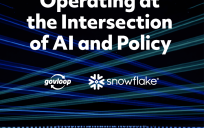Artificial intelligence (AI) has the potential to completely transform the way agencies serve their constituents. But before agencies can even begin to explore the many ways they can use AI — to improve their operations and develop a new generation of services — they must have a strong foundation of accessing and extracting value from their data.
The potential for transformation is stunning, but let’s remember the fundamentals first. What goes into a smart government is much more than an acquisition. Smart governments come from organizations that do the little things right and put the building blocks in place gradually. The first block is data. When data is transformed into useful, meaningful information, it becomes one of the most important public assets. To create the transformational solutions that drive a truly smart and innovative government, agencies must ensure that data can be easily accessed, efficiently stored and securely protected.
David Arnette is the Senior Technical Marketing Engineer at NetApp, which provides a full range of hybrid cloud data services that are designed to accelerate digital transformation. Arnette is focused on solutions for AI and machine learning workloads. At a recent GovLoop Virtual Summit, we spoke to him about how agencies can provide a solid data foundation for their AI programs.
This interview has been lightly edited for clarity and length.
GOVLOOP: How does data optimization help lay the groundwork for AI?
DAVID ARNETTE: One of the things we like to say is that data is the source code for AI. Typically, in software development, you have people writing software that makes things happen. But in the AI space, it’s almost reversed: The software is doing the writing, the software is learning to identify things, or classify transactions, based on its analysis of the data. So, the quality and the accessibility of the data are absolutely critical to success with these types of initiatives.
GOVLOOP: How might agencies figure out what problems they can solve with AI and machine learning?
DAVID ARNETTE: The first things I usually see customers look for are the low-hanging fruit – things that can deliver big impact without a lot of effort. In a lot of ways, that’s actually tied to the data that’s available at any given time. But when efforts are starting up and people are learning how to execute this type of program, they realize that they don’t have enough data or can’t get to it in a timely manner. That data exists, but it’s in a variety of different places and a variety of different formats. The key is to make sure that the right pieces of data are being collected in a centralized manner, so that they can be acted on holistically.
GOVLOOP: How do you create a data governance model that will aid AI? And to what extent is that model from agencies traditionally used?
DAVID ARNETTE: For AI initiatives, we see a lot of need for version control of the data, in addition to the code itself. This is a very collaborative environment, in which datasets often get combined. Once the data scientist has created a good dataset, it’s very useful to be able to share that dataset and provide a well-understood “access package” spelling out permissions for the team that might use it. And then that follows through all the way into archiving and cold storage of the data. At some point, we may need to reference the specific datasets that were used to train systems, so that data needs to be protected for longer periods of time and with more control and understanding of how that data relates to the other datasets that may be in use.
GOVLOOP: How do you see agencies moving forward with data optimization and AI in the next year? What’s on the horizon?
DAVID ARNETTE: I think everybody is starting to realize the importance of data. It’s gone through phases where, first, there was not enough of it, then there was too much, and now it’s becoming an accepted fact that the only way forward is to maintain and manage data. The other issue facing a lot of organizations is that data is spread across many physical and logical locations. Managing the data across all of that will be key to success in almost every organization.
This blog post is an excerpt from our new ebook, “How Data Drives Innovation in Government” Download the ebook to learn how smart governments use their data and artificial intelligence to power world-changing innovations here.






Leave a Reply
You must be logged in to post a comment.